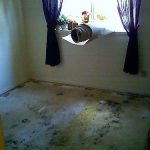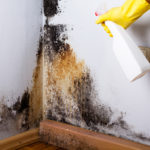Mold spores run rampant throughout the natural environment. Decayed leaves, rotting tree stumps, and various other natural debris are consumed by mold spores in the great outdoors. The moment mold spores latch on to indoor surfaces, people with mold allergies begin to adversely react.
What is a Mold Allergy?
Mold spores are present everywhere, indoors and outdoors. When an individual who is sensitive to mold inhales airborne mold spores, her immune system may begin to battle the intrusion into her nasal passages. As a result, antibodies, like histamine, are readily produced.
What are Mold Allergy Symptoms?
The antibodies that flock to the irritated areas to fight the inhaled spores are responsible for allergy symptoms, like wheezing, coughing, watery, and itchy eyes, throat and skin irritation and a runny nose. Mold allergy symptoms resemble a cold or sinus infection.
A person who is sensitive to mold and simultaneously suffers from asthma will experience compounded symptoms. The asthma symptoms only get worse when the sufferer is exposed to mold spores. Asthma symptoms, like wheezing or chest tightness, are signs of an asthma attack.
When do Mold Allergies Occur?
When the humidity levels rise due to heavy rains, the resulting environmental moisture is a hotbed for mold growth. Mold allergy sufferers will experience a heightened level of symptoms in wet weather. The summer and autumn seasons are notorious for provoking outdoor mold allergies.
High humidity levels indoors, plumbing leaks, foundation leaks, and continual condensation produce ideal moisture levels for mold colonies to establish and thrive inside a home. When excess moisture inside the property is left unaddressed, mold allergy sufferers will experience symptoms year-round.
How do Sufferers Prevent Mold Allergy Symptoms When Outdoors?
People who must head to the outdoors should check the pollen count and mold counts and spend time outside primarily when the counts are low. Updated mold levels for several locations are provided by the American Academy of Allergy, Asthma & Immunology.
Sufferers who must tend to outdoor work should wear a mask. The N95 mask is a type of filtering respirator that filters out 95 percent of floating particles, such as airborne mold spores. The Food and Drug Administration also clears certain surgical masks, like the Surgical N95 Respirators.
A home’s gutter system should be cleaned regularly to prevent decaying leaves from gathering. Decomposing natural debris, like leaves and twigs, attract mold spores. The prevalence of mold colonies near the roof and the spores’ airborne characteristic give spores a clear entryway into the home.
How do Sufferers Prevent Mold Allergy Symptoms When Indoors?
Regularly cleaning air filters and replacing air purifiers is a proactive method to prevent mold spores from infiltrating the home environment. When inside the home, keep windows tightly closed; airborne spores have easy access to the home when windows are left wide open.
Upon completing yardwork or activities outside, mold allergy sufferers should shower to wash off any mold spores latched onto the skin and hair. The clothes worn when working outside should be laundered and immediately dried. Wet clothes only attract moisture-seeking mold spores.
Repair any moisture leaks inside the home to prevent mold from flourishing. Common areas of the home that are exposed to water include the basement, crawl space and attic. Being light and airborne, mold spores can travel to any part of the home once it establishes a nutrient-rich base.
Running a dehumidifier reduces the level of moisture inside the home. Aim to sustain a humidity level under 50 percent to prevent the spores from feeding on indoor moisture. Turn on the vent fans in the bathrooms and kitchen to exhaust warm, damp air outside and increase ventilation inside.
What are Mold Allergy Treatment Options?
Over-the-counter allergy medications are helpful in warding off mold allergy symptoms. Antihistamines, nasal sprays, or decongestants can offer a suitable, temporary fix. Benadryl is an older antihistamine that causes drowsiness. Newer antihistamines, like Claritin or Allegra, have fewer undesirable side effects.
As a first line of defense against mold allergy symptoms, nasal corticosteroids are relied upon most frequently. Nasal corticosteroids can be over-the-counter or prescribed. Nasal sprays physically wash out the mold spores from the nostrils and flush the nasal passages with an antifungal.
While helpful, nasal sprays should not be used for more than three to four days; longer use can provoke congestion that worsens symptoms once use of the spray has stopped. Some experts claim nasal corticosteroids may be used for the long term, but common side effects, like nasal dryness, result.
Medications, like Singulair, are equally helpful. Taken as a tablet, this form of mold allergy treatment blocks immune system chemicals that are responsible for allergy symptoms. Medications are often prescribed when the sufferer has mild asthma or cannot tolerate nasal sprays.
Allergy shots offer long-lasting relief, but take effect after several monthly injections. A physician must first diagnose a mold allergy after conducting allergy tests. Once the doctor concludes the type of allergy and its severity, recommendations may be made to treat the allergies via allergy shots.
Mold allergies are rarely a life-threatening condition. However, mold allergies have a progressive nature and allergy attacks become worse over time. Properly addressing environmental conditions that support mold is key to reducing mold allergy symptoms.
Mold Remediation
When mold colonies permeate your home environment, you must immediately contact a reputable mold remediation professional. Skilled technicians arrive onsite to visually inspect the extent of the mold growth and immediately begin the remediation process. Even areas behind walls are subject to mold and are examined by professionals.
Attempting a DIY mold cleanup only scatters the mold spores to other areas of the home, contaminating these spaces in the process. Professional mold remediation experts utilize advanced equipment and chemicals to rid any residential or commercial business property of pesky mold.







